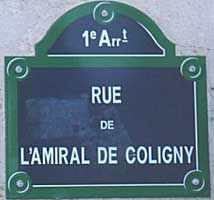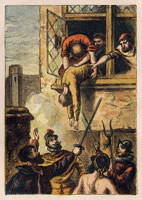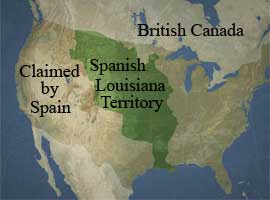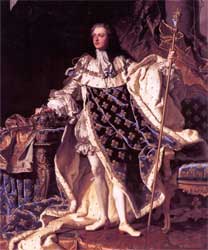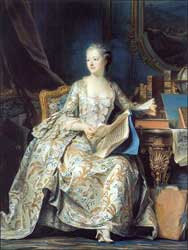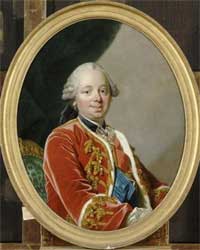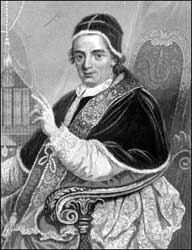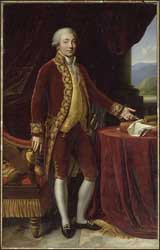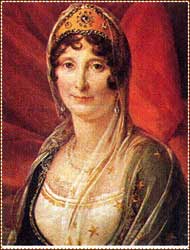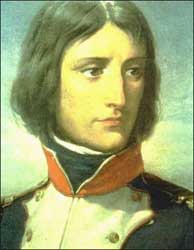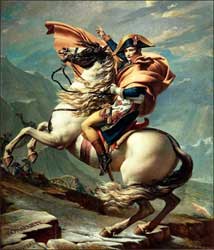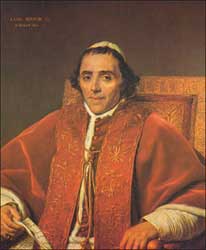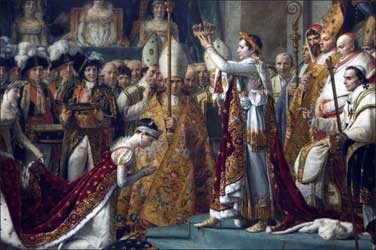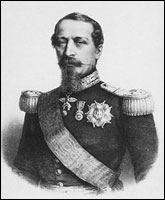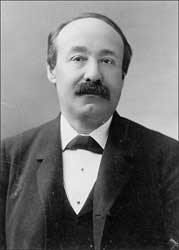ON AUGUST 15, 1534, THE MILITIA OF JESUS WAS FOUNDED BY IGNATIUS LOYOLA ON A HILLTOP OUTSIDE PARIS. OMINIOUSLY, THIS YEAR IS THE 490TH ANNIVERSARY OF THE FOUNDING OFTHE FIREBRAND FOR JESUS (DANIEL 9:24). |
The name FRANCE is derived from the Frankish word FRANK (De. FREI) and means free as in "Therefore if the Son makes you free, you shall be free indeed (Saint John 7:26).
Here is an English language quote based on a true history of France entitled Franco-Gallia by a Massacre survivor named François Hotman:
Gaul returned to a tradition of more freedom with the arrival of the Franks. They were originally a Germanic tribe living on the coasts of northern Europe, between the Rhine and the Elbe. Their very name reflects their love of freedom, as frank means "free" in German. The Franks were originally a fairly small band, but other Germanic peoples entering Gaul adopted their name out of admiration for their leading role in overthrowing the tyranny of the Romans. (Kingdon, Myths About the St. Bartholomew's Day Massacre, p. 143).
The old Frankish language was replaced by the French language which is a Romance language derived from Latin, with only a few Frankish words remaining to remind the French of the liberty-loving Franks.
The French Christians were given the derogatory name "Huguenot" by the Jesuits. Unlike the word "Protestant," which came from the corrupt Latin Vulgate Version, the origin of the word is still obscure.
On August 15, 1534, Ignatius Loyola and 6 of his companions founded the Jesuit order on a hilltop outside Paris. The deadly 6 founders were: Ignatius Loyola, Francis Xavier, Alfonso Salmeron, Diego Laínez, Nicolás Bobadilla, Peter Faber, and Simão Rodrigues. Francis Borgia, the grandson of Pope Alexander VI, and the éminence grise behind the new order—was
|
In 1540, Pope Paul III officially recognized the Militia of Jesus... In reality, the Jesuits were just warmed-over or incognito Franciscans....They were the shock troops or special forces of the Counter-Reformation. They were excused from chanting the Psalms; they did not have to wear the round tonsure, they were allowed to wear civilian clothes, and their general was elected for life.
The planning for the Massacre was as top secret as the Normandy D-Day landings date!!
The planning for the Massacre began immediately after the founding of the Jesuits. The glorious Reformation, begun in Germany on October 31, 1517, had spread to France–and was joyfully received. A great change had come over the people as industry and learning began to flourish, and so rapidly did the Truth spread that over a third of the French population of 20,000,000 embraced the Reformed Christian Faith.
True Christianity was also making progress at the highest echelon of French society. In 1521, Anne Boleyn—the future queen of England—returned from a 5-year-stay at the French Court . . . burning with zeal to rescue her nation from Papal darkness.
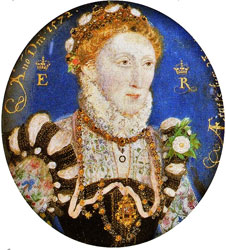 A miniature of the Queen Elizabeth double painted in 1572. |
|
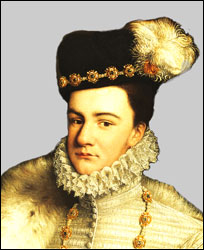 François, Duke of Anjou (1555–1584). |
All of "Queen Elizabeth's" portraits made her look at least 10 years younger, and it was not done to flatter her because she was born in 1540.
Naturally, the Queen Elizabeth double was given her marching orders by Sir William Cecil and Sir Francis Walsingham...Their main geostrategic goal was to sever the alliance between France and Scotland . . . and kickstart the British Empire with the union of the 3 kingdoms!
 Spymaster Sir William Cecil (1520–1598). |
|
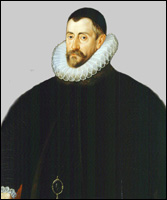 Sir Francis Walsingham (1532–1590). |
Walsingham "hid" in the British embassy and escaped the Massacre. He was not even FIRED for incompetence . . . but was promoted to become the queen's Secretary of State in 1573....That was an incredible failure of intelligence for the legendary British Secret Service!
The Massacre happened at a time of great friendship and ecumenical goodwill between the French Christians and the Vatican. The French Christians were derisively called "Huguenots" by the Latin Church.
Alarmingly for the Jesuits, the French Christians ignored the Bull of Borgia granting the entire New World to Spain. In 1562, Jean Ribault led a colonizing expedition to South Carolina . . . which was brutally wiped out by the Spaniards.
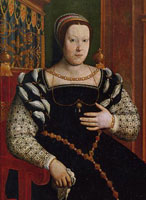 Portrait of Catherine de' Medici as a young woman. |
|
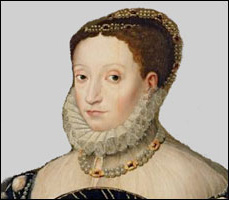 Catherine de' Medici (1519–1589). Proxy ruler of France from '33 to '89. |
Catherine married Henry II of France in 1533. For the first 10 years of their marriage she produced no children. In desperation, she entered into a pact with Lucifer himself, and eventually produced 10 "children." One of her daughters, Elizabeth, married Philip II of Spain.
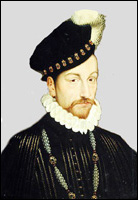 King Charles IX (1550–1574). King from 1561 to 1574. |
|
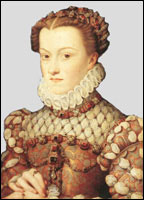 Elizabeth of Austria (1554–1592). Wife of King Charles. |
Charles was the eldest son of King Francis II (1544–1560), who suffered an untimely death in a jousting tournament. Charles was only 10-years-old at that time, so his mother Catherine became Regent, and de-facto ruler of the country. Unlike England, French Salic law prohibited females from inheriting the throne, otherwise Catherine would have joined Elizabeth of England and Mary Queen of Scots as an independent
The lure to get the admiral to Paris was the wedding of King Henry III of Navarre to Marguerite de Valois. Marguerite was the daughter of King Henry II of France and Catherine de' Medici.
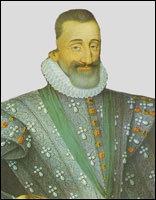
King Henry
IV (1553–1610).
King from 1589 to 1610). |
|

Marguerite
de Valois (1553–1615).
Wife of King Henry IV |
Admiral Coligny was without doubt the most famous man in France, and a leader in the French effort to plant the New Israel in the New World. The 1562 colony that was founded by Jean Ribault in South Carolina was wiped out by the Spaniards.
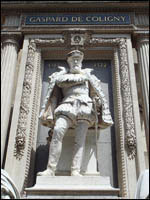
Admiral
Coligny's monument
in Paris, near the Louvre. |
|
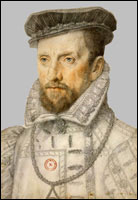 Admiral Coligny (1519-1572). |
On the morning of Friday, August 22, Admiral Coligny was walking back from the Louvre after a meeting with King Charles. The admiral was near home when suddenly he bent down to tie his shoelace. At that moment a shot rang out, wounding . . . but not killing the admiral:
On the morning of Friday, 22 August, the government recess for the marriage celebrations being now over, Admiral Gaspard de Coligny left his lodgings on the rue de Béthizy–today No. 144 rue de Rivoli–for a council meeting that was to start at nine o'clock. He had wished to press for French military intervention in Flanders, but to his frustration he found Anjou presiding over the meeting as the King had risen late. Anjou left the meeting early and when matters had been concluded the Admiral came across the King on his way with Téligny and the Duke of Guise to play a game of tennis. Charles begged Coligny to join him for a game but the Admiral refused. They parted at around eleven o'clock and Coligny left the Louvre for his short walk home, reading a document while he did so. As he approached the window at which Maurevert was hiding a binding on one of his shoes came loose and he bent down to fix it. Just as he did so, a shot rang out. The bullet broke his left arm and almost tore the index finger off his right hand. Had he not bent over at the critical moment he would have been mortally wounded. (Frieda, Catherine de Medici, p. 259).
Charles de Louviers, seignor de Maurevert, lay in wait for days to kill Admiral Coligny . . . but in the end his attempt ended in failure.
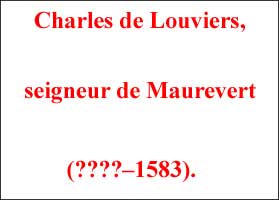 No portrait exists of assassin Charles de Louviers. |
|
Catherine didn't care if her son was killed in the "assassination" attempt because she was the real ruler of France. This false flag operation was similar to the Gunpowder Plot in England....Our Great JEHOVAH brought their wicked council to nothing:
JEHOVAH brings the counsel of the nations to nothing. He makes the plans of the peoples of no effect (Psalm 33:10).
To distinguish between the murderers and the French Christians, a white cross was sown on their hats.
The Massacred Christians were taken completely by surprise!!
August 24, 1572, was the date of the infamous Jesuit engineered St. Bartholomew's Day Massacre. On that day, over 400 years ago, began one of the most horrifying holocausts in history.
The Massacre began with the brutal murder of Admiral Coligny . . . in his bedroom.
 Henry, Duke of Guise (1550–1588). |
|
When Catherine de Medici heard the news of his death, she ordered the big bell of St. Germain L'Auxerrous to be rung. That was the agreed on signal for the Massacre to begin. Soon other church bells throughout the city began to ring and the deadly holocaust commenced.
 The Church of Saint-Germain L'Auxerrois. |
|
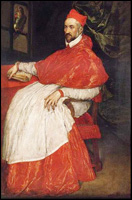 The Cardinal de Lorraine (1524–1574). |
If some of the murderers happened to be killed in the carnage, the priests and friars assured them that they would bypass "Purgatory" and go straight to heaven!
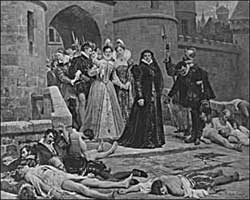 Catherine de' Medici rejoiced over the dead bodies of the French Christians. |
|
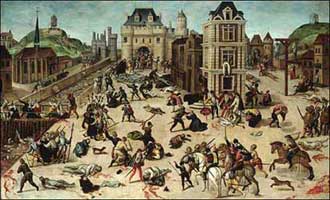 Catholics on the warpath in Paris to shorten their time in "Purgatory." |
When dawn broke on the morning of August 24, such a sight of carnage had never been seen in the entire history of the world. Paris was a literal Dante's Inferno slaughterhouse....Men, women, and children were stripped naked and their bodies horribly mutilated.
Catherine de' Medici came out to gloat over and inspect the bodies of the slain. She wondered if the bodies of the Christians were normal because they could not be seduced by her courtesans!.
After the brutal murder of Admiral Coligny, his head was cut off, and taken to the royal palace as a trophy for the king and queen mother. It was later embalmed and sent to Roma as a "present" for Pope Gregory XIII.
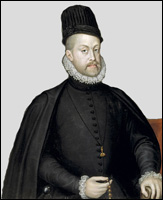 King Philip II (1527-1598). King from 1554 to 1598. |
|
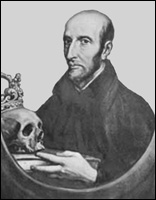 Francis Borgia (1510–1572). Jesuit general from 1565 to 1572. |
Beginning in Paris, the Massacre spread rapidly to all the cities, towns, and villages....The streets were awash with blood and the rivers were filled with dead bodies. Men, women, and children were all consumed by the murderous conflagration. Total victims exceeded 100,000. Not until the atomic bombing of Hiroshima were so many people killed in so short a time.
The Queen Elizabeth double heard the news on September 3:
By 22 August, the Queen had arrived at Kenilworth to be entertained by Leicester, who had arranged all kinds of 'princely sports.' But on 3 September, while she was out hunting one day, a messenger arrived with a dispatch from Walsingham in Paris that caused her to burst into tears, cancel all further entertainments and send de la Mole back to France. A Spanish agent in London informed Alva that she had 'sent all her musicians and minstrels home, and there are no more of the dances, farces and entertainments with which they have been amusing themselves lately, as they have some less agreeable things to think about.' (Weir, The Life of Queen Elizabeth I, p. 287).
The Queen Elizabeth double put on a good act of "grieving," while Mary Queen of Scots stayed up all night celebrating. Pope Gregory XIII was beside himself with joy.
Pope Gregory XIII designated Sept. 11 as a special day of "thanksgiving" for the Massacre!!
After the Massacre, Pope Gregory celebrated a Te Deum mass. Italian artist Giorgio Vasari painted 3 frescoes which still hang in the Sala Regia Palace next to the Cistine Chapel. A commemorate medal was struck with Gregory's portrait and on the obverse a chastising angel, sword in hand, and the legend UGONOTTORUM STRAGES ("Massacre of the Huguenots").
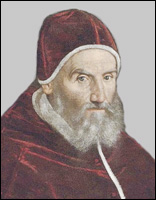 Pope Gregory XIII (1502–1585). Pope from1572 to 1585. |
|
Pope Gregory XIII was one of the most belligerent pontiffs in the Gregorian dynasty. His coat-of-arms actually included a DRAGON....The Jesuit Gregorian University in Roma is named in his "honor!"
The Massacre was a staggering blow to France from which it never fully recovered. Most of the Christians were artisans and belonged to the middle class. Many of them found a refuge in Germany, Switzerland, England, and Ireland and those countries benefited greatly by their industry and maritime skills.
The Jesuits Seven Years' War (1756–1763) or the First World War!!
The Jesuits were determined to fulfill the Bull of Pope Alexander VI and eliminate both the English . . . and French . . . from the New World. Jesuits in disguise in the English and French governments actually started a war between England and France called the Seven Years' War or the French and Indian Wars. The French call it the War of Conquest because they lost control of Canada.
The first shots of this worldwide conflict in the New World were fired by a youthful George Washington, who was sent on an expedition against the French in the Ohio country, a region claimed by Virginia. Great Britain declared war on France in May, 1756, and eventually the conflict spread to the whole world. Almost a million people died before a peace treaty was signed in 1763.
Incredible as it may seem, the Spanish ended up supplanting the French in the Louisiana Territory. This came to pass even though Spain fought with France against England!!
By 1762, France knew that she had lost the war. On Nov. 3, 1762, French King Louis XV signed a secret treaty with King Carlos III of Spain, giving him control of the Louisiana Territory. It was called the Treaty of Fountainebleau.
Protestant England was victorious in the Seven Years' War and had a golden opportunity to evict Spain from the New World for good. The charter for Virginia issued to Sir Walter Raleigh by Queen Elizabeth stretched from the Atlantic to the Pacific ocean.
Instead, she gave Spain control of the vast Louisiana Territory. Here is a brief quote from the Treaty of Paris signed in 1763:
George the Third, by the grace of God, King of Great Britain, France, and Ireland, Duke of Brunswick and Lunenbourg, Arch Treasurer and Elector of the Holy Roman Empire; the Most Serene and Most Potent Prince, Lewis the Fifteenth, by the grace of God, Most Christian King; and the Most Serene and Most Potent Prince, Charles the Third, by the grace of God, King of Spain and of the Indies, after having laid the foundations of peace in the preliminaries signed at Fontainebleau the third of November last; and the Most Serene and Most Potent Prince, Don Joseph the First, by the grace of God, King of Portugal and of the Algarves, after having acceded thereto, determined to compleat, without delay, this great and important work.
The war was a disaster for France and King Louis XV knew that the Jesuits were the ringleaders in that conflict. The king was eager to ban the firebrands from his kingdom . . . but fearful because of a Jesuit assassination attempt on his life in 1757.
King Louis had a beautiful and brilliant mistress named Jeanne-Antoinette Poisson Marquise (later Duchesse) de Pompadour, also known as Madame de Pompadour.
Madame de Pompadour supported the king's able minister for foreign affairs named Étienne-François, duc de Choiseul, and together they engineered the downfall of the Jesuits in France and the other Bourbon kingdoms of Spain, Portugal, the Two Sicilies, Parma, Naples etc., etc.
|
That move cost Madame de Pompadour her life as she died of poison at the young age of 43. The first attack on the Jesuits was made by the abbé Chauvelin on April 27, 1761, who demanded that Parlement suppress them:
On April 27, 1761, the abbé Chauvelin, one of the most radical members of parlement, denounced the Jesuits as the opponents of good order, ecclesiastical discipline, and the maxims of the kingdom. 'As a Christian, a citizen, a Frenchman, a subject of the King and a magistrate,' the abbé cried, 'is it not necessary to examine the institution and the régime of the Jesuits? That is what I ask you, Messieurs, to consider.' The Jesuits were already unpopular, unjustly suspected of complicity with the would-be assassin Damiens, of foreign intrigue, a fifth column, out of the state's control. When parlement, in its verdict on May 8, demanded that the society pay one-and-a-half million livres to their creditors, there was wild enthusiasm in the streets of Paris. Next, parlement appointed a commission to review the whole question of the Jesuits position in French society. (Algrant, Madame de Pompadour, p, 267).
This was followed by further edicts until the king finally banished them from France entirely at the end of November 1764.
In 1773, Pope Clement XIV banned the Jesuit Order by a perpetual decree!!
The French king, through his minister for foreign affairs Étienne-François, duc de Choiseul, FORCED the Pope to dissolve the Jesuits order entirely in the dominions of the Bourbon kings.
|
The new Pope was very, very reluctant because he feared the cup of Borgia and wasn't ready to meet his Maker.
He finally relented and in 1773 issued a Bull suppressing them PERPETUALLY and FOREVER.
On July 21, 1773, this "infallible" Pope banned the Jesuit order by a perpetual decree never to be rescinded. It cost him his life as he was given the cup of Borgia shortly thereafter and died a horrible lingering death:
Even the Papal States refused to give the Jesuits refuge and they were finally dumped on the island of Corsica.And to this end a member of the regular clergy, recommendable for his prudence and sound morals, shall be chosen to preside over and govern the said houses; so that the name of the Company shall be, and is, for ever extinguished and suppressed. (Bull of Suppression of Pope Clement XIV).
The banished Spanish Jesuits ended up on the island of Corsica!!
Even before the Bull of Clement was issued, the Jesuits were suppressed by King Charles III of Spain. That enlightened monarch was a foe of the Jesuits and the Spanish Inquisition.
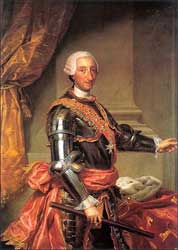 King Charles III of Spain (1716–1788). Reigned from 1759 to 1788. |
|
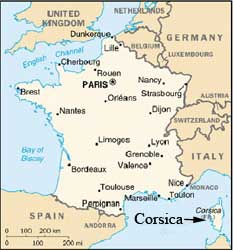 The island of Corsica, just south of France, was a haven for the Jesuits. |
The Papal States refused to receive them and they ended up on the French owned island of Corsica.
The king of Spain used great secrecy and ordered that nobody was to divulge the planned expulsion of the Jesuits under pain of death:
When all measures were ready, despatches were sent from Madrid to all the governors of all the Spanish possessions of Africa, Asia, America, and throughout all the peninsula. These despatches, signed by the king, and counter-signed by D'Aranda, were sealed with three seals. On the second envelope was written, 'Under pain of death, you shall not open this despatch but on the 2d April 1767, towards the closing of the day.' The orders to be executed in the different places, on the 2d of April, were all of the same tenor. The alcaldes were enjoined, on the severest penalties (Crétineau says on pain of death) immediately to enter the establishments of the Jesuits armed, to take possession of them, to expel the Jesuits from their convents, and to transport them within twenty-four hours as prisoners to such ports as were designated. The fathers were to embark instantly, leaving their papers under seal, and carrying away with them only a breviary, a purse, and some apparel. The orders were executed everywhere with the utmost rigour, and six thousand Jesuits were very soon floating at the same time on the waste ocean on their way to the coast of Italy. (Nicolini, History of the Jesuits, pp. 355-356).
The Papal States refused to allow those sons of LIEola to land and they finally found a refuge on the island of Corsica:
Torrigiani obeyed Ricci's injunction to the letter. When after some days sailing the first vessels arrived before Civita Vecchia, they were received by cannon shot. The poor Jesuits, who thought they were near the end of their sufferings, and had smiled at the sight of the promised land, were furious when they saw themselves rejected from a country in which they knew that their General had the utmost influence, and loudly accused him of being the author of all their miseries. The Spanish commander, not wishing to employ violence, and to land by force of arm, coasted away towards Leghorn and Genoa, but there too they were refused a landing. A similar fate was reserved for them on their first approach to Corsica; and only after having been for six long months at the mercy of the winds and waves, were those unfortunate monks, decimated by illness, fatigue, and old age, permitted to disembark in Corsica, lately ceded by Genoa to France, and where Paoli at that same moment had begun to fight for independence. (Nicolini, History of the Jesuits, p. 358).
The Jesuits–who had taken a vow of poverty–were fabulously rich but the Spanish government found nothing in their monasteries; they must have seen the handwriting on the wall and hidden the money beforehand.
Napoleon Bonaparte was born on the island of Corsica!!
It so happens that the man who shook the world for 20 years was born on Corsica in the year 1769. His name: Napoleon Bonaparte.
The world was told that Carlo Maria Bonaparte was the father of Napoleon. He could not possible be the REAL father. The Jesuits were famous or rather infamous for seducing the wives of kings and rulers in the confessional. The offspring of such unions were often passed of as legitimate children.
|
This was plainly the case in the birth of Napoleon as his subsequent career plainly reveals. The war loving Napoleon declared war on all the Bourbon kings that had banished the Jesuits. He tried to bring England to her knees and invaded Russia in 1812. He finally restored the Jesuits in 1814.
|
Napoleon made war on all the Bourbon kings; he declared war on England, invaded Russia, and last but not least had the Jesuits restored in 1814.
Napoleon was crowned Emperor of the French in 1804
In the short interval of 40 year since the banning of the Jesuits, there was a total of 4 Popes. Finally in 1800, a Pope was "elected" that would be favorable to Napoleon and his Jesuits. Pius VII traveled to Paris for Napoleon's coronation in 1804.
|
|
Nothing seemed to stand in Napoleon's way and his ambition knew no bounds. He wanted to make himself master of all of Europe, so in 1812, he launched his disastrous invasion of Russia.
On June 18, 1815, the Battle of Waterloo was fought in which Napoleon was defeated and forced into permanent exile on the island of Saint Helena in the South Atlantic. He died there on May 5, 1821.
Pope Pius VII removed the perpetual ban of his predecessor!!
In 1801, Pope Pius VII signed a Concordat with Napoleon Bonaparte and crowned him Emperor of France in 1804.
On Sunday, the 7th of August 1814, Pius VII, went in state to the church of the Gesù, celebrating himself the mass before the altar consecrated to Loyola; heard a second mass, immediately after which he caused to be read and promulgated the bull by which the Society of Jesus was re-established according to the ancient rules. (Nicolini, History of the Jesuits, p. 439).
In a Papal brief issued on August 7, 1814, this "infallible" Pope contradicted a previous "infallible" Pope:
By the same brief, we received the congregation of the Company of Jesus under our immediate protection and dependence, reserving to ourselves and our successors the prescription of everything that might appear to us proper to consolidate, to defend it, and to purge it from the abuses and corruptions that might be therein introduced; and for this purpose we expressly abrogated such apostolical constitutions, statutes, privileges, and indulgences, granted in contradiction to these concessions, especially the apostolic letters of Clement XIV., our predecessor, which begun with the words Dominus ac Redemptor Noster, only in so far as they are contrary to our brief, beginning Catholicae and which was given only for the Russian empire. (Bull of Restoration of Pope Pius VII).
Many nations, especially France and Portugal, did not accept this resurrection of the Society of Zeus and Minerva.
The Napoleonic dynasty
Even after the demise of Bonaparte, his dynasty continued to rule many of the countries of Europe. Here are just 2 of the Bonapartes who played a major role in world events.
|
Finally in 1870, he was the final prop to the Pope's temporal power before the loss of the Papal States.
Charles Joseph Bonaparte was a grandson of Jérôme Bonaparte (the youngest brother of the French emperor Napoleon I), and attorney general in the Roosevelt administration from 1906 to 1909.
He founded the Bureau of Inquisition which later became know as the "Confederate" Bureau of Inquisition or the FBI. He also founded an organization called the American Protective League which spied on patriotic people who exposed Rome's activities. People confused it with the patriotic U.S. Protective Association or the APA.
Vital Links
References
Algrant, Christine Pevitt. Madame de Pompadour, Mistress of France. Grove Press, New York. 2002.
Bernier, Olivier. Louis the Beloved. The Life of Louis XV. Doubleday & Co., Garden City, New York, 1984.
Crowdy, Terry. The Enemy Within: A History of Spies, Spymasters and Espionage. Osprey Publishing, Oxford, UK, 2006.
Erickson, Carolly, The First Elizabeth. St. Martin's Press, New York, 1983.
Frieda, Leonie. Catherine de Medici: Renaissance Queen of France. HarperCollins Publishers, New York, 2003.Hotman, François. Franco-Gallia: or, an Account of the Ancient Free State of France. Tim. Goodwin, London, 1711.
Haynes, Alan. Walshingham: Elizabethan Spymaster and Statesman. Sutton Publishing, Gloustershire, UK, 2007.
Kingdon, Robert M. Myth's About the St. Bartholomew's Day Massacre, Harvard University Press, Cambridge, MASS, 1988.
Lever, Evelyne. Madame de Pompadour. A Life. Farrar, Straus and Giroux, New York, 2000.
Nicolini, G.B. History of the Jesuits. George Bell & Sons, London & New York, 1893.
Noguerès, Henry. The Massacre of Saint Bartholomew. The Macmillan Company, New York, 1959.
Smith, H.C. The Bonapartes. The History of a Dynasty. Hambledon & London, London & New York, 2000.
Somerset, Anne, Elizabeth I. St. Martin's Griffin, New York, 1991.
Weir, Alison. The Life of Queen Elizabeth I. Ballantine Books, New York, 1998.
Copyright © 2014 by Patrick Scrivener


